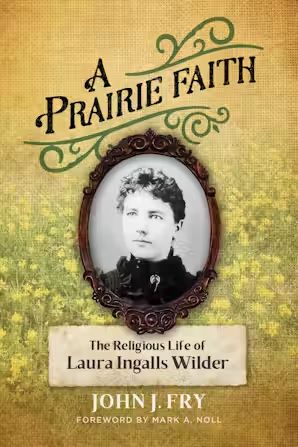
John J. Fry
Reviewed by: Hannah Schmidt
A Prairie Faith: The Religious Life of Laura Ingalls Wilder, by John J. Fry. Eerdmans, 2024. Paperback, 240 pages, $24.99. Reviewed by OP member Hannah Schmidt.
Growing up on the wide-open plains of North Dakota, my imagination was captured by The Little House on the Prairie and Laura Ingalls Wilder’s other novels for children. Laura and her family attended church, sang hymns, and prayed for spring after long, icy winters, just as my family did. John J. Fry in A Prairie Faith asks what role religion played in the life of Laura Ingalls Wilder. It was not as great a role as one might assume from reading the Little House series. She was a moderate Protestant but had little to say about her own religious beliefs and practices, believing that “the things between one and God should be between him and God” (4). Wilder’s preference for privacy about spiritual matters restricts what Fry, an OP elder and professor of history at Trinity Christian College, can say about her faith; nevertheless he faithfully and thoroughly portrays the spiritual life of a woman who was neither a fundamentalist nor a liberal, but a conventional Christian.
Laura Ingalls Wilder based her popular books for children on her own experiences growing up on the American frontier at the close of the nineteenth century. Her memoir Pioneer Girl remained unpublished during her lifetime, but her daughter, Rose, convinced Wilder to modify and fictionalize tales from her youth to make them more appealing for publication. Thus began a writing partnership that spanned decades. Rose, who rejected traditional Christianity and was attracted to Islam, “both added to and subtracted from [the Little House books’] engagement with spiritual topics” (136). For example, The Long Winter contains references to heaven, Genesis, Psalms, Proverbs, and Daniel, and detailed accounts of Bible memorization and prayer. Almost all these references were added by Rose or modified in some way (155). Similar modifications can be found in all the books. Although Laura had a Christian upbringing, the spiritual quality of her life was sometimes exaggerated for the novels.
Fry brings a uniquely Christian and Reformed perspective to the study of Wilder’s life. His analysis includes Wilder’s personal correspondence, newspaper articles, and journals. Wilder attended church regularly throughout her life, though Fry notes that she did not typically attend evening services or attend church while traveling. Wilder participated in Congregational, Methodist, and Methodist Episcopal churches, but she never became a member of one, even when other family members did. Her single encounter with Scottish Presbyterians was a negative one—she felt constrained by their strict Sabbatarianism and rejected the doctrine of predestination (54). Most likely Wilder would not have sought out an OPC church!
Readers of the Little House books may be surprised to learn from A Prairie Faith that Wilder made false claims about her books. To the end of her life Wilder asserted that all the Little House books were true and strictly biographical. Fry writes that “this was clearly not true. Laura and Rose combined historical characters, left out people who had lived with the family, and created some stories out of whole cloth” (200). This revelation could inspire further discussion among readers about the boundaries between fact and fiction.
Overall, Fry reveals Laura Ingalls Wilder to have been a flawed but persevering Christian who sought to do good and attend church. He notes that Wilder writes more of God’s law than his grace. This is sad, since there are many instances in the novels that could be mined for examples of human and divine mercy. Fry refrains from exploring how Wilder’s novels may have influenced the faith of her readers. Having grown up reading the stories as an example of Christianity, I would have been interested to read more about Wilder’s faith legacy.
July 27, 2025
July 20, 2025
July 13, 2025
Proclaiming Christ in a Pluralistic Age
July 06, 2025
June 29, 2025
June 22, 2025
June 15, 2025
© 2025 The Orthodox Presbyterian Church